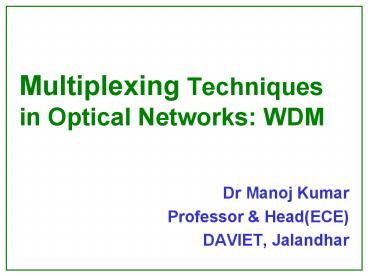Multiplexing Techniques in Optical Networks: WDM - PowerPoint PPT Presentation
1 / 28
Title:
Multiplexing Techniques in Optical Networks: WDM
Description:
Multiplexing Techniques in Optical Networks ... Tunable Optical Filter Tunable Source Optical amplifier Add-drop Multiplexer and De-multiplexer DWDM ... – PowerPoint PPT presentation
Number of Views:417
Avg rating:3.0/5.0
Title: Multiplexing Techniques in Optical Networks: WDM
1
Multiplexing Techniques in Optical Networks WDM
- Dr Manoj Kumar
- Professor Head(ECE)
- DAVIET, Jalandhar
2
Multiple Access Methods
- TDMA Time Division Multiple Access
- Done in the electrical domain
- SCMA Sub Carrier Multiple Access
- FDM done in the electrical domain
- CDMA Code Division Multiple Access
- Not very popular
- WDMA Wavelength Division Multiple Access (The
most promising)
3
Sub Carrier Multiplexing
- Widely used in CATV distribution
4
A Closer Look.
Transmitting End
Baseband Data
Baseband-RF Modulation
RF-Optical Modulation
Two different Modulations for each RF Carrier !
Single Mode Fiber
Gain BPF
RF-Baseband Demodulation
Optical - RF Demodulation
Baseband Data
Receiving End
200 THz
1.8 GHz
5
Sub Carrier Multiplexing
Unmodulated (main) carrier
f2
f2
f1
f1
f0
Frequency
Sub-carriers
- Each modulating RF carrier will look like a
sub-carrier - Unmodulated optical signal is the main carrier
- Frequency division multiplexed (FDM) multi
channel systems also called as SCM
6
Sub Carrier Multiplexing
- Ability to both analog and digitally modulated
sub-carriers - Each RF carrier may carry voice, data, HD video
or digital audio - They may be modulated on RF carriers using
different techniques - Performance analysis is not straightforward
7
CATV Distribution
- 50-88 MHz and 120-550 MHz spectrum is allocated
for CATV - Either AM or FM technique for RF ? Optical
conversion - AM Simple implementation, but SNR gt 40 dB for
each channel, high linearity required - FM The information is frequency modulated on RF
before intensity modulating the laser, better SNR
and less linearity requirement
8
TDMA
- Signals are multiplexed in time
- This could be done in electrical domain (TDMA) or
optical domain (OTDMA) - Highly time synchronized transmitter/receiver
- Stable and precise clocks
- Most widely used (SONET, GPON etc.)
9
Wavelength Division multiplexing
Each wavelength is like a separate channel (fiber)
10
TDM Vs WDM
SONET
11
Wavelength Division Multiplexing
- Passive/active devices are needed to combine,
distribute, isolate and amplify optical power at
different wavelengths
12
Why WDM?
- Capacity upgrade of existing fiber networks
(without adding fibers) - Transparency Each optical channel can carry any
transmission format (different asynchronous bit
rates, analog or digital) - Scalability Buy and install equipment for
additional demand as needed - Wavelength routing and switching Wavelength is
used as another dimension to time and space
13
Evolution of the Technology
14
Review of Modes
- Multimode Fiber There are several
electro-magnetic modes that are stable within the
fiber, Ex TE01, TM01 - The injected power from the source is distributed
across all these modes - WDM is not possible with multimode fibers
- Single Mode Fiber Only the fundamental mode will
exist. - All the coupled energy will be in this mode. This
mode occupies a very narrow spectrum making
Wavelength Division Multiplexing possible
15
Multimode Laser Spectrum
Multimode Lasers are not suitable for DWDM
systems (two wide spectrum)
16
Photo detector Responsivity
- Photo detectors are sensitive over wide spectrum
(600 nm). - Hence, narrow optical filters needed to separate
channels before the detection in DWDM systems
17
Optical Amplifiers are key in DWDM systems
18
WDM, CWDM and DWDM
- WDM technology uses multiple wavelengths to
transmit information over a single fiber - Coarse WDM (CWDM) has wider channel spacing (20
nm) low cost - Dense WDM (DWDM) has dense channel spacing (0.8
nm) which allows simultaneous transmission of 16
wavelengths high capacity
19
WDM and DWDM
- First WDM networks used just two wavelengths,
1310 nm and 1550 nm - Today's DWDM systems utilize 16, 32,64,128 or
more wavelengths in the 1550 nm window - Each of these wavelength provide an independent
channel (Ex each may transmit 10 Gb/s digital or
SCMA analog) - The range of standardized channel grids includes
50, 100, 200 and 1000 GHz spacing - Wavelength spacing practically depends on
- laser linewidth
- optical filter bandwidth
20
ITU-T Standard Transmission DWDM windows
21
Principles of DWDM
- BW of a modulated laser 10-50 MHz ? 0.001 nm
- Typical Guard band 0.4 1.6 nm
- 80 nm or 14 THz _at_1300 nm band
- 120 nm or 15 THz _at_ 1550 nm
- Discrete wavelengths form individual channels
that can be modulated, routed and switched
individually - These operations require variety of passive and
active devices
Ex. 10.1
22
Nortel OPTERA 640 System
64 wavelengths each carrying 10 Gb/s
23
Key components for WDM
- Passive Optical Components
- Wavelength Selective Splitters
- Wavelength Selective Couplers
- Active Optical Components
- Tunable Optical Filter
- Tunable Source
- Optical amplifier
- Add-drop Multiplexer and De-multiplexer
24
DWDM Limitations
- Theoretically large number of channels can be
packed in a fiber - For physical realization of DWDM networks we need
precise wavelength selective devices - Optical amplifiers are imperative to provide long
transmission distances without repeaters
25
(No Transcript)
26
(No Transcript)
27
Types of Fiber
- Dispersion Optimized Fiber
- Non-zero dispersion shifted fiber (NZ-DSF)? 4
ps/nm/km near 1530-1570nm band - Avoids four-way mixing
- Dispersion Compensating Fiber
- Standard fiber has 17 ps/nm/km DCF has -100
ps/nm/km - 100 km of standard fiber followed by 17 km of DCF
? zero dispersion
28
Summary
- DWDM plays an important role in high capacity
optical networks - Theoretically enormous capacity is possible
- Practically wavelength selective (optical signal
processing) components decide it - Passive signal processing elements like FBG are
attractive - Optical amplifications is imperative to realize
DWDM networks

